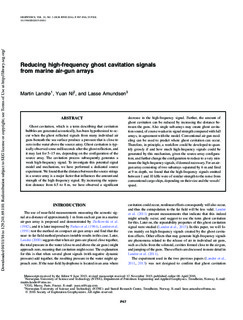| dc.description.abstract | Ghost cavitation, which is a term describing that cavitation bubbles are generated acoustically, has been hypothesized to occur when the ghost reflected signals from many individual air guns beneath the sea surface produce a pressure that is close to zero in the water above the source array. Ghost cavitation is typically observed some milliseconds after the ghost reflection, and it may last for 5–15 ms, depending on the configuration of the source array. The cavitation process subsequently generates a weak high-frequency signal. To investigate this potential signal model and mechanism, we have performed a dedicated source experiment. We found that the distance between the source strings in a source array is a major factor that influences the amount and strength of the high-frequency signal. By increasing the separation distance from 6.5 to 8 m, we have observed a significant decrease in the high-frequency signal. Further, the amount of ghost cavitation can be reduced by increasing the distance between the guns. Also single sub-arrays may create ghost cavitation sound, of course weaker in signal strength compared with full arrays, in agreement with the model. Conventional air-gun modeling can be used to predict where ghost cavitation can occur. Therefore, in principle, a workflow could be developed to quantify grossly if and how much high-frequency signals could be generated by this mechanism, given the source array configuration, and further change the configuration to reduce to a very minimum the high-frequency signals, if deemed necessary. For an air-gun array consisting of two subarrays separated by 6 m and fired at 9 m depth, we found that the high-frequency signals emitted between 1 and 10 kHz were of similar strength to the noise from conventional cargo ships, depending on their size and the vessels’ speed. | nb_NO |
